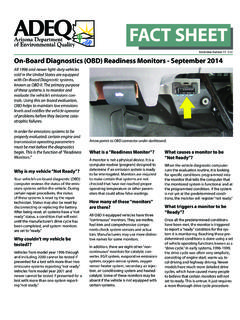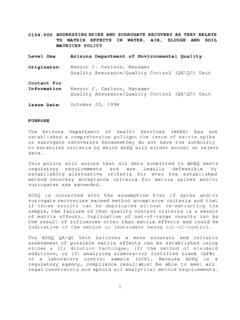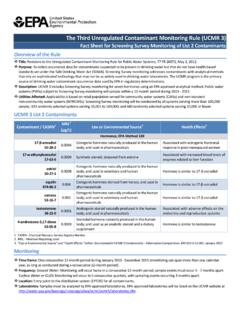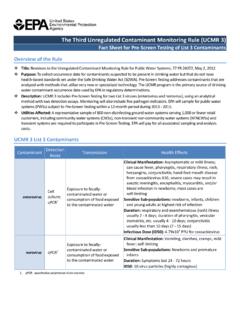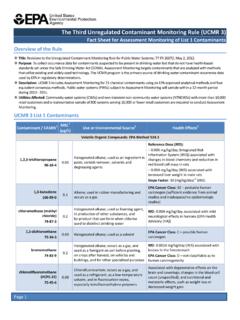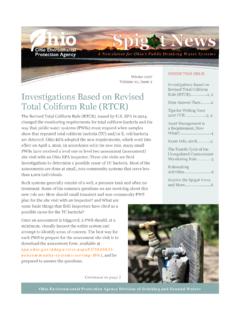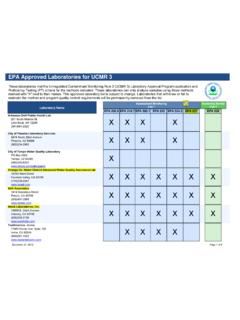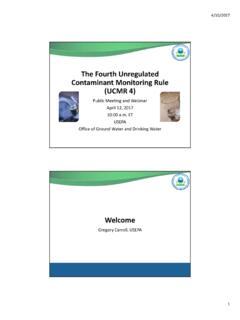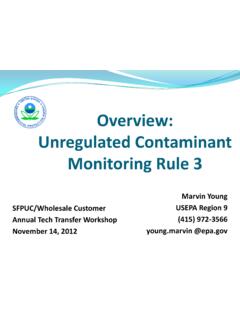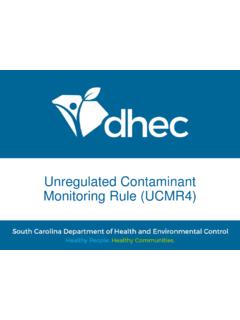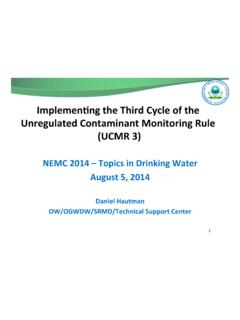Transcription of The Third Unregulated Contaminant Monitoring Rule (UCMR …
1 The Third Unregulated Contaminant Monitoring Rule (UCMR 3) Fact Sheet for Assessment Monitoring of List 1 Contaminants Overview of the Rule Title: Revisions to the Unregulated Contaminant Monitoring Rule for Public Water Systems; 77 FR 26072, May 2, 2012. Purpose: To collect occurrence data for contaminants suspected to be present in drinking water but that do not have health based standards set under the Safe Drinking Water Act (SDWA). Assessment Monitoring targets contaminants that are analyzed with methods that utilize existing and widely used technology. The UCMR program is the primary source of drinking water Contaminant occurrence data used by EPA in regulatory determinations. Description: UCMR 3 includes Assessment Monitoring for 21 chemical contaminants using six EPA approved analytical methods and four equivalent consensus methods. Public water systems (PWSs) subject to Assessment Monitoring will sample within a 12 month period during 2013 2015.
2 Utilities Affected: Community water systems (CWSs) and non transient non community water systems (NTNCWSs) with more than 10,000 retail customers and a representative sample of 800 systems serving 10,000 or fewer retail customers are required to conduct Assessment Monitoring . UCMR 3 List 1 Contaminants MRL2 Contaminant / CASRN1 Use or Environmental Source3 Health Effects3 ( g/L) Volatile Organic Compounds; EPA Method Reference Dose (RfD): mg/kg/day (Integrated Risk Information System [IRIS]) associated with Halogenated alkane; used as an ingredient in 1,2,3 trichloropropane changes in blood chemistry and reduction in paint, varnish remover, solvents and 96 18 4 red blood cell mass in rats degreasing agents mg/kg/day (IRIS) associated with increased liver weight in male rats Slope Factor: 30 (mg/kg/day) 1 (IRIS) EPA Cancer Class: B2 probable human 1,3 butadiene Alkene; used in rubber manufacturing and carcinogen (sufficient evidence from animal 106 99 0 occurs as a gas studies and inadequate/no epidemiologic studies) Halogenated alkane.
3 Used as foaming agent, chloromethane (methyl RfD: mg/kg/day associated with mild in production of other substances, and chloride) neurological effects in humans (EPA Health by product that can form when chlorine 74 87 3 Advisory [HA]) used to disinfect drinking water 1,1 dichloroethane EPA Cancer Class: C possible human Halogenated alkane; used as a solvent 75 34 3 carcinogen Halogenated alkane; occurs as a gas, and RfD: mg/kg/day (IRIS) associated with bromomethane used as a fumigant on soil before planting, lesions in the forestomach 74 83 9 on crops after harvest, on vehicles and EPA Cancer Class: D not classifiable as to buildings, and for other specialized purposes human carcinogenicity Associated with degenerative effects on the Chlorofluorocarbon; occurs as a gas, and chlorodifluoromethane brain and coverings; changes in the blood cell used as a refrigerant, as a low temperature (HCFC 22) count (unspecified); and nutritional and solvent, and in fluorocarbon resins, 75 45 6 metabolic effects, such as weight loss or especially tetrafluoroethylene polymers decreased weight gain Page 1 MRL2 Contaminant / CASRN1 Use or Environmental Source3 Health Effects3 ( g/L) bromochloromethane Used as a fire extinguishing fluid, an RfD: mg/kg/day associated with increased (Halon 1011) explosive suppressant, and as a solvent in liver to body weight ratio and other metabolic 74 97 5 the manufacturing of pesticides effects (EPA HA) Synthetic Organic Compound: EPA Method 522 RfD: mg/kg/day associated with liver and kidney toxicity (IRIS) EPA 10 4 Lifetime Cancer Risk: mg/L Cyclic aliphatic ether; used as a solvent or Slope Factor: solvent stabilizer in manufacture and 1,4 dioxane (mg/kg/day) 1 (IRIS) processing of paper, cotton, textile products, 123 91 1 automotive coolant, cosmetics and (mg/kg/day) 1 (IRIS Draft.)
4 74 FR 21361) shampoos EPA Cancer Class: B2 probable human carcinogen (sufficient evidence from animal studies and inadequate/no epidemiologic studies) Metals: EPA Method ; SM 3125; ASTM D5763 104 Naturally occurring elemental metal; used Associated with altered kidney function vanadium as vanadium pentoxide which is a chemical indicated by increased blood urea and mild 7440 62 2 intermediate and a catalyst tissue changes Naturally occurring element found in ores RfD: mg/kg/day (IRIS) associated with molybdenum and present in plants, animals and bacteria; increased uric acid levels. 1 7439 98 7 commonly used form molybdenum trioxide EPA Cancer Class: D not classifiable as to used as a chemical reagent human carcinogenicity Naturally occurring element found in the earth's crust and at low concentrations in Associated with effects on blood (increased cobalt 1 seawater, and in some surface and ground hemoglobin, polycythemia) and effects on lung 7440 48 4 water; cobaltous chloride was formerly used function in medicines and as a germicide Naturally occurring element; historically, RfD: mg/kg/day associated with rachitic strontium commercial use of strontium has been in the bone (rickets) (IRIS) 7440 24 6 faceplate glass of cathode ray tube EPA Cancer Class: D not classifiable as to televisions to block x ray emissions human carcinogenicity See chromium 6 for use or source information.
5 Though the amount measured when analyzing for "total chromium" is the chromium5 sum of chromium in all of its valence states, See chromium 6 for health effects information. CASRN n/a the MCL for EPA's current total chromium regulation was determined based upon the health effects of chromium 6. Chromium 6: EPA Method RfD: mg/kg day (IRIS, 1998) (basis for MCL) Naturally occurring element; used in making mg/kg day (IRIS, 2005) (basis for HRL) steel and other alloys. Chromium 3 or 6 chromium 66 Draft RfD: mg/kg day associated with forms are used for chrome plating, dyes and 18540 29 9 intestinal lesions (IRIS, Draft 75 FR 60454) pigments, leather tanning, and wood preservation Draft Slope Factor: (mg/kg day) 1 (IRIS, Draft 75 FR 60454) Page 2 MRL2 Contaminant / CASRN1 Use or Environmental Source3 Health Effects3 ( g/L) Oxyhalide Anion: EPA Method ; SM 4110D; ASTM D658 08 RfD: mg/kg/day associated with enlarged chlorate Agricultural defoliant or desiccant; used in 20 thyroid and mineralization (Office of Pesticide 14866 68 3 production of chlorine dioxide Programs) Perfluorinated Compounds: EPA Method 537 Surfactant or emulsifier.
6 Used in fire fighting NOAEL: mg/kg/day associated with foam, circuit board etching acids, alkaline perfluorooctanesulfonic decreased body weights, increased liver cleaners, floor polish, and as a pesticide acid (PFOS) weights, lowered total cholesterol, lowered active ingredient for insect bait traps; 1763 23 1 triiodothyronine (T3) concentration, and manufacture of PFOS phased out in 2002; lowered estradiol levels (EPA Provisional HA) however, PFOS still generated incidentally Perfluorinated aliphatic carboxylic acid; used for its emulsifier and surfactant properties in perfluorooctanoic acid Associated with body weight reduction, and or as fluoropolymers (such as Teflon), (PFOA) increased liver, kidney and brain weight fire fighting foams, cleaners, cosmetics, 335 67 1 relative to body weight greases and lubricants, paints, polishes, adhesives and photographic films perfluorononanoic acid Manmade chemical; used in products to (PFNA) make them stain, grease, heat and water Associated with liver effects 375 95 1 resistant perfluorohexanesulfonic Manmade chemical; used in products to Associated with immune and lymphatic acid (PFHxS) make them stain, grease, heat and water system, neurological, reproductive and 355 46 4 resistant developmental effects perfluoroheptanoic acid Manmade chemical; used in products to Contaminant is similar to other perfluorinated (PFHpA) make them stain, grease, heat and water compounds 375 85 9 resistant perfluorobutanesulfonic Manmade chemical; used in products to Associated with decreased blood proteins and acid (PFBS) make them stain, grease, heat and water blood volume and tissue changes in kidney 375 73 5 resistant 1.
7 CASRN Chemical Abstracts Service Registry Number 2. MRL Minimum Reporting Level 3. "Use or Environmental Source" and "Health Effects" further documented in UCMR 3 Contaminants Information Compendium. EPA 815 B 11 001. January 2012 4. SM Standard Methods; ASTM ASTM International 5. Monitoring for total chromium, in conjunction with UCMR 3 Assessment Monitoring , is required under the authority provided in Section 1445(a)(1)(A) of SDWA 6. Chromium 6 will be measured as soluble chromate ion (CASRN 13907 45 4) Monitoring Time frame: One consecutive 12 month period during January 2013 December 2015 ( Monitoring can span more than one calendar year, as long as conducted during a consecutive 12 month period). Frequency: Ground Water: Monitoring will occur twice in one consecutive 12 month period. Sample events must occur 5 7 months apart. Surface Water or GUDI: Monitoring will occur in 4 consecutive quarters, with sampling events occurring 3 months apart.
8 Location: Entry point to the distribution system (EPTDS) for all contaminants, as well as distribution system maximum residence time sampling locations for total chromium, chromium 6, cobalt, molybdenum, strontium, vanadium and chlorate. Laboratories: Samples must be analyzed by EPA approved laboratories. EPA approved laboratories will be listed on the UCMR website at Page 3 Critical Deadlines and Requirements Report Contact Due Date Requirement through Sampling SDWARS1 Coordinator2. Following Rule Publication Systems must submit contact information to SDWARS. (Any subsequent X changes must be submitted within 30 days of the change occurring). October 1, 2012 Laboratories seeking approval must submit a registration form to participate in the laboratory approval process. For more information see: X Ground water systems that wish to monitor from representative EPTDSs August 1, 2012 must submit either state approved, UCMR 2 approved or propose a new X representative sampling plan.
9 Deadline for systems to change their Monitoring schedule (after October 1, X (after systems must provide an explanation for the requested schedule change X October 1) October 1, 2012 and obtain EPA approval of the change). PWSs review/edit if necessary, inventory information for sampling X (after X locations. October 1) Following Sample Collection Within 120 days of sample Laboratories post data to SDWARS. X collection PWSs review and approve the data. If the PWS has not taken action after Within 60 days of 60 days, the data are considered approved and ready for state and EPA X lab posting data review. 1. Safe Drinking Water Accession and Review System; at 2. Contact via email at: UCMR List 1 Data Elements Public Water System Sampling Point Identification (PWSID) Sample Collection Date Analytical Method Code Analytical Result Value Identification Code Code Public Water System Sampling Point Type Sample Identification Laboratory Identification Facility Identification Sample Analysis Type Code Code Code Code Water Source Type Disinfectant Type Contaminant Analytical Results Sign Sample Event Code Additional Information The Public Notification Rule (40 CFR ), published Under the Consumer Confidence Report (CCR) Rule, as specified on May 4, 2000 (65 FR 25982) with amendments and in 40 CFR (d), CWSs must report the Monitoring results corrections included in the Code of Federal Regulations for whenever Unregulated contaminants are detected.
10 CCRs are to the Public Notification Rule published on July 1,2006, be sent to all billing customers each year by July 1. (The CCR Rule requires PWSs to notify the public annually that the results does not apply to non community water systems). Details on of Monitoring for Unregulated contaminants are available. these reporting requirements can be found on the CCR Home CWSs may include their public notice within their CCRs. Page at: Details on these reporting requirements can be found in the For More Information document: Revised Public Notification Handbook (EPA 816 R 09 013), available on EPA's website at: Safe Drinking Water Hotline: (800) 426 4791 CDX/SDWARS Help Desk: (888) 890 1995 ation/ Page 4 Office of Water (4607 M) EPA 815 F 12 003 May 2012



